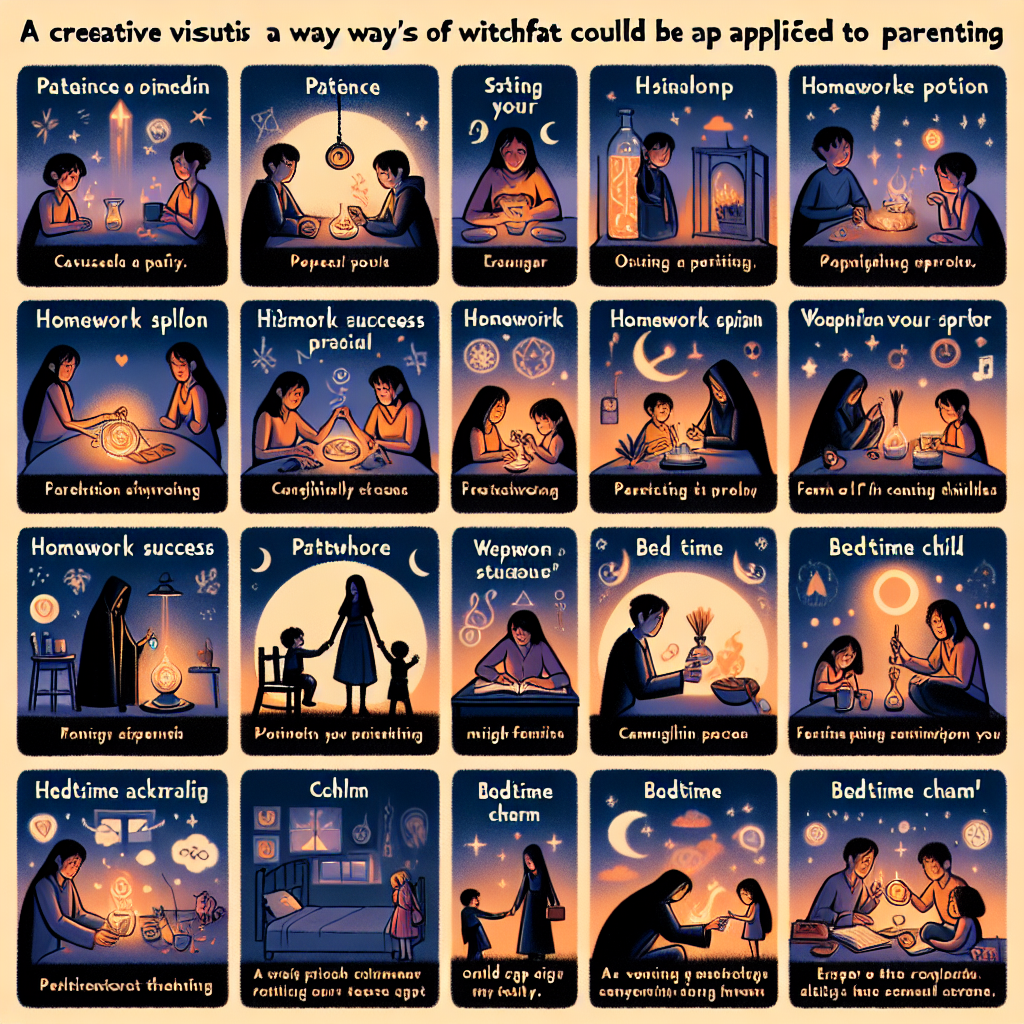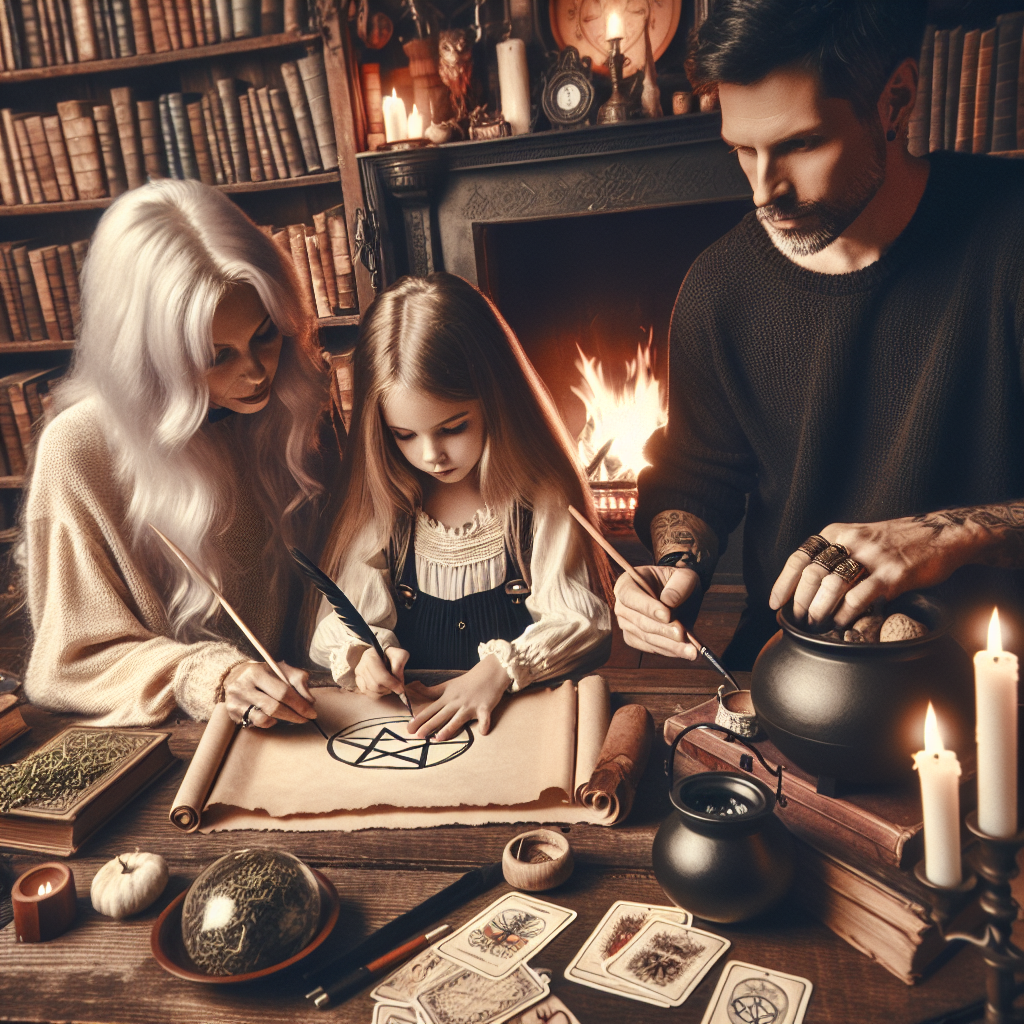As an Amazon Associate I earn from qualifying purchases.
↻
Last updated: December 24, 2025

Witchcraft, a practice that involves the use of magical faculties, often has a deep-rooted connection with nature and the unseen energies of the world. Historically, witchcraft has been practiced in various cultures worldwide and has often been passed down through generations. In recent times, the term “witchcraft” has been redefined by some as a spiritual path or lifestyle that focuses on harmony with the earth and the use of natural energies to bring balance and healing. This reimagined perspective on witchcraft has found its way into various aspects of daily life, including parenting.
In the context of parenting, witchcraft can be employed in a metaphorical sense to mean using intuition, nature-based practices, and a nurturing approach to raise well-rounded children. The concept of '18 Ways to Use Witchcraft in Parenting' implies a collection of methods or approaches that leverage this redefined version of witchcraft, focusing on the emotional, spiritual, and physical wellbeing of children. This methodology has gained interest among parents who seek to incorporate holistic and earth-centered practices into their family life.
One engaging element of using witchcraft in parenting is the creation of rituals to mark significant events in a child's life. These rituals can provide a sense of tradition and belonging, helping children to connect with family heritage and the cycles of nature. A compelling statistic that correlates with this approach is the increase in families celebrating non-traditional ceremonies, such as naming ceremonies instead of standard christenings, indicating a shift towards more personalized and meaningful family traditions.
Another practice includes using herbal remedies to alleviate common childhood ailments. Many parents who follow this path pride themselves on their knowledge of herbalism and natural medicine, often preferring these methods over conventional medicines for treating minor conditions. For example, rather than using over-the-counter drugs for colds, they might use a homemade elderberry syrup as an immune booster.
Affirmations and positive thinking are also components of witchcraft that are used in parenting. Teaching children the power of their thoughts and words aligns with the Law of Attraction's principles, which are often emphasized in modern witchcraft. By encouraging children to speak positively about themselves and their capabilities, parents can instill confidence and a growth mindset.
Lastly, the value of nature in this practice cannot be understated. Families might spend time outdoors during different phases of the moon to discuss the lunar cycle's significance, which also serves as an excellent opportunity to bond and instill a reverence for nature's rhythms. Engaging with the natural world in this manner helps to foster environmental stewardship and a sense of wonder.
As these practices are shared and adapted, they form a tapestry of parenting strategies interwoven with the elements of witchcraft – each strand representing a different technique to guide and nurture children in a holistic and spiritually attuned manner.
1. **Creating a Peaceful Home Atmosphere**
Using witchcraft parenting, one can work with calming spells or energy work to promote serenity within the home. These practices might include burning soothing incense during a hectic household evening or hanging amulets that are believed to foster peace and tranquility.
2. **Protection Rituals for Children**
Various traditions within witchcraft endorse the use of symbols and rituals for protection. Parents might consider crafting protective talismans that their children can carry with them to school or place under their beds for safe sleeping.
3. **Herbal Remedies for Minor Ailments**
Witchcraft often incorporates knowledge of herbs and their healing properties. Parents might use herbal teas or baths to address minor ailments like colds or skin irritations, always ensuring to use safe practices and consulting with healthcare providers when necessary.
4. **Fostering Connection with Nature**
Encouraging a connection with nature is a core element of many witchcraft practices. Parents might facilitate nature walks, gardening, or outdoor rituals that help children appreciate the natural world and its cycles.
5. **Mindfulness and Meditation**
Teaching children mindfulness through meditation can be considered part of witchcraft parenting. These techniques can help children learn to calm their minds, manage emotions, and develop deep concentration skills.
6. **Celebrating Seasonal Festivals**
Many witchcraft traditions honor the cycle of the seasons through various festivals. By participating in these celebrations, families can embrace the changing world around them, fostering a sense of rhythm and harmony within the family unit.
7. **Cultivating Gratitude Rituals**
Practices of giving thanks and showing gratitude to the earth, the universe, or deities can be incorporated into daily routines, such as before meals or at bedtime, to help instill a sense of gratitude in children.
8. **Energy Cleansing**
The concept of purifying or cleansing energy can be part of witchcraft parenting. This might include using sage to smudge the house, promoting clean and positive energy, or having a special bath with salts and herbs.
9. **Moon Rituals**
Considering the phases of the moon can be a form of witchcraft. Parents and children can take part in rituals that align with the moon's phases, such as setting intentions on a new moon or releasing negativity on a full moon.
10. **Storytelling and Mythology**
Sharing stories and myths that feature witches, fairies, or other magical beings can spark children’s imaginations and teach valuable life lessons through metaphor and allegory.
11. **Crystal Healing**
Implementing crystals in the home for their supposed healing qualities is another example of witchcraft parenting. Families might select specific stones for their perceived properties—like rose quartz for love—and place them around the home or on a child’s bedside table.
12. **Charm Bags or Pouches**
Creating small pouches filled with herbs, stones, and symbols can serve as a practice of witchcraft. These charm bags might be designed to help a child with specific challenges, such as anxiety or difficulty focusing.
13. **Visualization Techniques**
Visualization is a powerful tool in witchcraft. Parents can guide children through visualizations to promote positive outcomes, such as picturing themselves succeeding in a test or sports game.
14. **Empowerment Spells**
While controversial and subject to personal beliefs, some parents may use spoken affirmations or ‘spells' to build their children's self-confidence and resilience in the face of challenges.
15. **Teaching Respect for All Living Things**
A fundamental principle in witchcraft is respect for all life. This lesson can be integrated into parenting by emphasizing compassion and empathy towards humans, animals, and the environment.
16. **Dream Interpretation**
Engaging with children’s dreams and helping them to interpret the symbols and narratives can be an enriching experience, potentially offering insights into their subconscious mind.
17. **Using Music and Chanting**
Music and chanting can be used to create a specific atmosphere or to help focus and meditate. Using songs and chants with children can be both educational and a bonding experience, especially if they relate to historical or spiritual themes.
18. **Creating Magical Crafts**
Engaging in crafts that have a ‘magical' aspect—like making natural dye from plants or weaving dreamcatchers—can be both educational and spiritually enriching for children.
A statistic reported by the Pew Research Center in 2020 showed that roughly six-in-ten Americans (62%) express belief in at least one of a series of spiritual concepts identified by the survey as “New Age” (which can include elements related to witchcraft), demonstrating the continuing interest and integration of such practices in modern society.
Frequently Asked Questions
1. What is witchcraft parenting?
Witchcraft parenting is an approach that incorporates beliefs and practices from witchcraft or nature-based spirituality into the daily aspects of raising children. This can include teaching children about the natural world, the cycles of life, energy work, and using rituals or spells to promote positive outcomes and values.
2. Is witchcraft parenting safe for children?
Yes, when practiced responsibly and ethically, witchcraft parenting is safe. It emphasizes respect for nature, understanding of energies, and developing a sense of personal and social responsibility, which can be beneficial for children's growth and development.
3. Does using witchcraft in parenting require a belief in the supernatural?
Not necessarily. While it often includes metaphysical elements, witchcraft parenting can also be practiced in a more symbolic or metaphorical sense, focusing on the natural rhythms and energies without invoking supernatural beliefs.
4. How can I integrate witchcraft into my parenting without overwhelming my child?
Start with simple practices such as celebrating seasonal festivals, discussing the energy of plants and stones, or creating family rituals that foster a sense of connection. The key is to go slowly and let your child's curiosity and comfort level guide the process.
5. Can witchcraft parenting be combined with other religious beliefs?
Yes, witchcraft is often seen as a practice rather than a dogma and can be integrated with different religious beliefs. Parents should find a balance that honors their family's unique spiritual or religious perspectives.
6. What if my partner disagrees with witchcraft parenting?
It's important to have open and respectful discussions with your partner about parenting styles. Compromise and find common ground, such as focusing on the aspects of witchcraft that align with shared values like respect for nature and personal growth.
7. Are there community resources for witchcraft parenting?
Many communities have groups or gatherings for those interested in nature-based spirituality where parents can share and learn from others. Online forums and social media groups are also good places to connect with like-minded individuals.
8. What are some simple witchcraft practices I can introduce to my kids?
Herb gardening, meditation, creating a family altar, celebrating the solstices and equinoxes, and teaching about herbal remedies are simple practices that can introduce children to witchcraft in an accessible way.
9. How do I address negative stereotypes about witchcraft with my children?
Education is key. Explain the history and modern practices of witchcraft, emphasizing the positive aspects and debunking common misconceptions. Teach them that witchcraft, like any belief, should be approached with respect and understanding.
10. Will my child be bullied for witchcraft parenting practices?
It's possible, as with any belief system that differs from the mainstream. Equip your children with the confidence to explain their beliefs calmly and respectfully, and teach them coping strategies for dealing with bullying or misunderstandings should they occur.

Conclusion
Employing witchcraft in parenting serves as a unique approach to fostering a nurturing and imaginative environment for children. Key aspects such as establishing a daily ritual can create stability while incorporating natural elements teaches respect and appreciation for the earth. Additionally, using intention setting as a family encourages goal-setting and visualization of success. Creating a family altar not only becomes a focal point for shared spirituality but also reinforces family bonds and cultural heritage. Mindfulness and meditation practices instill a sense of peace and provide tools for emotional regulation. Crafting and using talismans can stimulate creativity while offering a sense of security and protection. By integrating these practices into parenting, children develop into well-rounded individuals with a keen sense of their place in the world and the interconnectedness of all living things.
The guidance shared in the article emphasizes the importance of communication and respect when integrating witchcraft into family life. Teaching ethical principles alongside magical practices ensures that children learn to use witchcraft responsibly and with good intention. Celebrating seasonal festivals provides opportunities for family bonding and education on the cycles of nature. Moreover, dreamwork and storytelling not only enhance imagination but also offer avenues for exploring personal and collective unconscious. By weaving witchcraft into the tapestry of parenting, we allow our children to grow up with an enriched understanding of magic and its place in the world, ultimately equipping them with unique skills and perspectives to navigate life's challenges.
Amazon and the Amazon logo are trademarks of Amazon.com, Inc, or its affiliates.
Continue Your Magical Journey
Free Witchcraft Starter Kit
Get 6 free printable PDFs: grimoire pages, moon calendar, spells, crystals, herbs, and tarot journal.
We respect your privacy. Unsubscribe anytime.
Enhance Your Practice
As an Amazon Associate, I earn from qualifying purchases.

